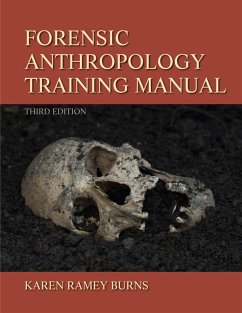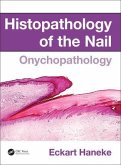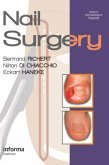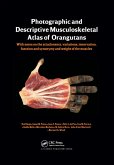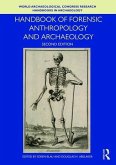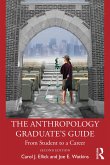For laboratory courses in human osteology (human skeletal anatomy) and forensic anthropology at the junior/senior level.
This manual is designed to serve three purposes: to be used as a general introduction to the field of forensic anthropology; as a framework for training; and as a practical reference tool. The text will make students aware of the challenges and responsibilities of the forensic scientist, the multidisciplinary nature of the work, and the international potential for the forensic sciences.
Product Description
Provides basic information on successfully collecting, processing, analyzing, and describing skeletal human remains.
Forensic Anthropology Training Manual serves as a practical reference tool and a framework for training in forensic anthropology.
The first chapter informs judges, attorneys, law enforcement personnel, and international workers of the information and services available from a professional forensic anthropologist. The first section (Chapters 2-11) is a training guide to assist in the study of human skeletal anatomy. The second section (Chapters 12-17) focuses on the specific work of the forensic anthropologist, beginning with an introduction to the forensic sciences.
Learning Goals
Upon completing this book readers will be able to:
Have a strong foundation in human skeletal anatomy
Explain how this knowledge contributes to the physical description and personal identification of human remains
Understand the basics of excavating a grave, preparing a forensic report, and presenting expert witness testimony in a court of law
Define forensic anthropology within the broader context of the forensic sciences
Describe the work of today's forensic anthropologists
Note: MySearchLab does not come automatically packaged with this text. To purchase MySearchLab, please visit: www.mysearchlab.com or you can purchase a ValuePack of the text + MySearchlab (at no additional cost): ValuePack ISBN-10: 0205207308 / ValuePack ISBN-13: 9780205207305.
Features + Benefits
Tables and formulae, such as vocabulary references and standard measuring tools, are provided for general use and reference throughout the book. (ex: p. 54, 138)
Forms are available in the appendix for use in the field or laboratory. (ex: p. 303)
Line drawings prepared by a professional scientific illustrator provide students realistic illustrations that draw attention to distinguishing details. (ex: p. 27, 128)
Chapters are presented in a sequence designed for effective teaching:
Basic human osteology precedes laboratory analysis, and all information on the skeleton is completed before the chapters on field work and specific applications.
Racial analysis is placed after the osteology section because it requires a working knowledge of cranial anatomy and experience with osteometrics.
A bibliography and comprehensive glossary are included. (p. 333, 317)
MySearchLab can be packaged with this text.
MySearchLab provides engaging experiences that personalize learning, and comes from a trusted partner with educational expertise and a deep commitment to helping students and instructors achieve their goals.
Writing and Research - A wide range of writing, grammar and research tools and access to a variety of academic journals, census data, Associated Press newsfeeds, and discipline-specific readings help you hone your writing and research skills.
Create a Custom Text: For enrollments of at least 25, create your own textbook by combining chapters from best-selling Pearson textbooks and/or reading selections in the sequence you want. To begin building your custom text, visit www.pearsoncustomlibrary.com. You may also work with a dedicated Pearson Custom editor to create your ideal text-publishing your own original content or mixing and matching Pearson content. Contact your Pearson Publisher's Representative to get started.
1. BRIEF TABLE OF CONTENTS
Chapter 1. Introduction to Forensic Anthropology
Chapter 2. The Biology of Bone and Joints
Chapter 3. The Skull and Hyoid
Chapter 4. The Shoulder Girdle and Thorax: Clavicle, Scapula, Ribs, and Sternum
Chapter 5. The Vertebral Column
Chapter 6. The Arm: Humerus, Radius, and Ulna
Chapter 7. The Hand: Carpals, Metacarpals, and Phalanges
Chapter 8. The Pelvic Girdle: Illium, Ishium, and Pubis
Chapter 9. The Leg: Femur, Tibia, Fibula, and Patella
Chapter 10. The Foot: Tarsals, Metatarsals, and Phalanges
Chapter 11. Odontology (Teeth)
Chapter 12. Introduction to the Forensic Sciences
Chapter 13. Laboratory Analysis
Chapter 14. Race and Cranial Measurements
Chapter 15. Field Methods
Chapter 16. Professional Results
Chapter 17. Large-Scale Applications
Provides basic information on successfully collecting, processing, analyzing, and describing skeletal human remains. Forensic Anthropology Training Manual serves as a practical reference tool and a framework for training in forensic anthropology. The first chapter informs judges, attorneys, law enforcement personnel, and international workers of the information and services available from a professional forensic anthropologist. The first section (Chapters 2-11) is a training guide to assist in the study of human skeletal anatomy. The second section (Chapters 12-17) focuses on the specific work of the forensic anthropologist, beginning with an introduction to the forensic sciences. Learning Goals Upon completing this book readers will be able to: Have a strong foundation in human skeletal anatomy Explain how this knowledge contributes to the physical description and personal identification of human remains Understand the basics of excavating a grave, preparing a forensic report, and presenting expert witness testimony in a court of law Define forensic anthropology within the broader context of the forensic sciences Describe the work of today's forensic anthropologists
Hinweis: Dieser Artikel kann nur an eine deutsche Lieferadresse ausgeliefert werden.
This manual is designed to serve three purposes: to be used as a general introduction to the field of forensic anthropology; as a framework for training; and as a practical reference tool. The text will make students aware of the challenges and responsibilities of the forensic scientist, the multidisciplinary nature of the work, and the international potential for the forensic sciences.
Product Description
Provides basic information on successfully collecting, processing, analyzing, and describing skeletal human remains.
Forensic Anthropology Training Manual serves as a practical reference tool and a framework for training in forensic anthropology.
The first chapter informs judges, attorneys, law enforcement personnel, and international workers of the information and services available from a professional forensic anthropologist. The first section (Chapters 2-11) is a training guide to assist in the study of human skeletal anatomy. The second section (Chapters 12-17) focuses on the specific work of the forensic anthropologist, beginning with an introduction to the forensic sciences.
Learning Goals
Upon completing this book readers will be able to:
Have a strong foundation in human skeletal anatomy
Explain how this knowledge contributes to the physical description and personal identification of human remains
Understand the basics of excavating a grave, preparing a forensic report, and presenting expert witness testimony in a court of law
Define forensic anthropology within the broader context of the forensic sciences
Describe the work of today's forensic anthropologists
Note: MySearchLab does not come automatically packaged with this text. To purchase MySearchLab, please visit: www.mysearchlab.com or you can purchase a ValuePack of the text + MySearchlab (at no additional cost): ValuePack ISBN-10: 0205207308 / ValuePack ISBN-13: 9780205207305.
Features + Benefits
Tables and formulae, such as vocabulary references and standard measuring tools, are provided for general use and reference throughout the book. (ex: p. 54, 138)
Forms are available in the appendix for use in the field or laboratory. (ex: p. 303)
Line drawings prepared by a professional scientific illustrator provide students realistic illustrations that draw attention to distinguishing details. (ex: p. 27, 128)
Chapters are presented in a sequence designed for effective teaching:
Basic human osteology precedes laboratory analysis, and all information on the skeleton is completed before the chapters on field work and specific applications.
Racial analysis is placed after the osteology section because it requires a working knowledge of cranial anatomy and experience with osteometrics.
A bibliography and comprehensive glossary are included. (p. 333, 317)
MySearchLab can be packaged with this text.
MySearchLab provides engaging experiences that personalize learning, and comes from a trusted partner with educational expertise and a deep commitment to helping students and instructors achieve their goals.
Writing and Research - A wide range of writing, grammar and research tools and access to a variety of academic journals, census data, Associated Press newsfeeds, and discipline-specific readings help you hone your writing and research skills.
Create a Custom Text: For enrollments of at least 25, create your own textbook by combining chapters from best-selling Pearson textbooks and/or reading selections in the sequence you want. To begin building your custom text, visit www.pearsoncustomlibrary.com. You may also work with a dedicated Pearson Custom editor to create your ideal text-publishing your own original content or mixing and matching Pearson content. Contact your Pearson Publisher's Representative to get started.
1. BRIEF TABLE OF CONTENTS
Chapter 1. Introduction to Forensic Anthropology
Chapter 2. The Biology of Bone and Joints
Chapter 3. The Skull and Hyoid
Chapter 4. The Shoulder Girdle and Thorax: Clavicle, Scapula, Ribs, and Sternum
Chapter 5. The Vertebral Column
Chapter 6. The Arm: Humerus, Radius, and Ulna
Chapter 7. The Hand: Carpals, Metacarpals, and Phalanges
Chapter 8. The Pelvic Girdle: Illium, Ishium, and Pubis
Chapter 9. The Leg: Femur, Tibia, Fibula, and Patella
Chapter 10. The Foot: Tarsals, Metatarsals, and Phalanges
Chapter 11. Odontology (Teeth)
Chapter 12. Introduction to the Forensic Sciences
Chapter 13. Laboratory Analysis
Chapter 14. Race and Cranial Measurements
Chapter 15. Field Methods
Chapter 16. Professional Results
Chapter 17. Large-Scale Applications
Provides basic information on successfully collecting, processing, analyzing, and describing skeletal human remains. Forensic Anthropology Training Manual serves as a practical reference tool and a framework for training in forensic anthropology. The first chapter informs judges, attorneys, law enforcement personnel, and international workers of the information and services available from a professional forensic anthropologist. The first section (Chapters 2-11) is a training guide to assist in the study of human skeletal anatomy. The second section (Chapters 12-17) focuses on the specific work of the forensic anthropologist, beginning with an introduction to the forensic sciences. Learning Goals Upon completing this book readers will be able to: Have a strong foundation in human skeletal anatomy Explain how this knowledge contributes to the physical description and personal identification of human remains Understand the basics of excavating a grave, preparing a forensic report, and presenting expert witness testimony in a court of law Define forensic anthropology within the broader context of the forensic sciences Describe the work of today's forensic anthropologists
Hinweis: Dieser Artikel kann nur an eine deutsche Lieferadresse ausgeliefert werden.

